'Mission complete:' Atlantis returns to Earth, closing out final shuttle flight
Editor's note...
CBS News
KENNEDY SPACE CENTER, FL--By the light of a waning moon, the shuttle Atlantis fell back to Earth Thursday, dropping out of predawn darkness to close out NASA's 135th and final shuttle voyage, a long-awaited -- and long-dreaded -- milestone marking the end of an era for American manned space flight.
Coming home to a future clouded by tight budgets and uncertain political support, commander Christopher Ferguson guided Atlantis through a sweeping left overhead turn and lined up on runway 15, quickly descending into the glare of powerful xenon spotlights.
Approaching the 3-mile-long runway, Ferguson pulled the shuttle's nose up in a graceful flare, pilot Douglas Hurley lowered the ship's landing gear and Atlantis settled to a tire-smoking touchdown at 5:57:00 a.m. EDT (GMT-4). A few seconds later, as Atlantis barreled down the runway at more than 200 mph, Hurley deployed a red-and-white braking parachute and the shuttle's nose gear settled to the runway.
"Having fired the imagination of a generation, a ship like no other, its place in history secured, the space shuttle pulls into port for the last time, its voyage at an end," said mission control commentator Rob Navias.
A few moments later, Atlantis coasted to a halt on the runway centerline, bringing three decades of shuttle operations to a close.
"Mission complete, Houston," Ferguson radioed. "After serving the world for over 30 years, the space shuttle has earned its place in history. It's come to a final stop."
"We copy your wheels stopped, and we'll take this opportunity to congratulate you, Atlantis, as well as the thousands of passionate individuals across this great, space-faring nation who truly empower this incredible spacecraft, which for three decades has inspired millions around the globe," replied astronaut Barry "Butch" Wilmore from mission control in Houston. "Job well done, America."
"Hey thanks, Butch, great words, great words," Ferguson said. "You know, the space shuttle has changed the way we view the world and it's changed the way we view our universe. There are a lot of emotions today, but one thing is indisputable -- America's not going to stop exploring.
"Thank you Columbia, Challenger, Discovery, Endeavour and our ship, Atlantis," he said. "Thank you for protecting us and bringing this program to such a fitting end. God bless all of you, God bless the United States of America."
Ferguson, Hurley, Sandra Magnus and flight engineer Rex Walheim doffed their 70-pound pressure suits and joined dozens of NASA managers, engineers and contractors, many awaiting layoffs, for a traditional runway inspection, smiling and sharing hugs and handshakes as they celebrated a safe homecoming.
"They have come to be known as the 'final four,' and they did an absolutely incredible job," said NASA Administrator Charles Bolden. "We've been exploring since early in our country's history. What Fergie and his crew did this time was kind of close out this era of our exploration. I want everybody who was involved in this to feel incredibly proud. ... We owe an incredible debt of gratitude to the tens of thousands, if not hundreds of thousands of folk around the country who made all this possible."
Ferguson spoke briefly for the crew, saying "There was a lot of attention paid to this mission, because it does bring to a final close 30 years of space shuttle history."
"Although we got to take the ride, we sure hope that everybody who's ever worked or touched or looked at or envied or admired a space shuttle was able to take just a little part of the journey with us," he said. "We're going to put Atlantis in a museum now, along with the other orbiters, for generations that will come after us, to admire and appreciate.
"On behalf of the crew, thanks so much for the time and attention," he said. "For the folks at KSC, thank you for this fantastic vehicle. It performed absolutely wonderfully, not a glitch, and it's just as pristine as it was, I hope, on the day that we took it."
Landing closed out a voyage spanning 5.3 million miles and 200 complete orbits since blastoff July 8 from nearby launch pad 39A, a mission duration of 12 days 18 hours 27 minutes and 56 seconds. Over the course of 33 missions, Atlantis logged an estimated 125,935,769 miles, 4,848 orbits and 307 days in space.
Launch Director Mike Leinbach captured the mood of many at the Florida spaceport when he described Atlantis' homecoming as a family affair tinged with sadness and hope for the future.
"I heard nothing but pride out on the runway today," he said. "When I talked to people between the hugs and the pats on the back, the pride that they have of having been part of this amazing program, this amazing bit of history. No one can ever take that away from us."
During a virtually trouble-free mission, Ferguson and his crewmates delivered five-and-a-half tons of supplies and equipment to the International Space Station and helped with a spacewalk to retrieve a failed coolant pump.
The supplies are critical to the space station program. Two companies, Space Exploration Technologies -- SpaceX -- and Orbital Sciences, are building unmanned cargo ships to take over from the shuttle after the fleet is retired with initial test flights expected later this year or early next.
Atlantis' mission was added to the shuttle manifest to deliver enough supplies to keep the station provisioned through 2012 as a hedge against development problems that might delay the commercial cargo ships.
Now, with Atlantis and its crew safely home, the emotional process of remembrance and celebration finally began in earnest as engineers and technicians marveled anew at the technological grandeur of the winged spaceplane and struggled to cope with the reality that it will never fly again.
"Out on the runway, I found myself, as I did with Discovery and Endeavour, taking in the beauty of the vehicle, standing back and taking pictures, taking pictures of the workers, them asking for a picture with me, it was just a family event out there today," Leinbach said. "Hard to describe the emotions. There were good emotions that we brought the crew home safely, and the mission's complete, certainly sadness that it's over and people will be moving on.
"Hate to see them leave," he said, "but that's a reality. I saw grown men and grown women crying today. Tears of joy, to be sure, just human emotions came out on the runway today. You couldn't suppress them."
Ferguson and his crewmates no doubt felt those same emotions.
"After the wheels have stopped and the displays go blank and the orbiter is unpowered for the final time ... there will be a rush of emotion when we all finally realize that's it, that it's all over, the crowning jewel of our space program, the way we got back and forth from low-Earth orbit for 30 years ... we'll realize that's all over," Ferguson said before launch. "That's going to take a little while to deal with."
The landing also brought into sharp focus the post-Columbia decision by the Bush administration to complete the space station and retire the shuttle to make way for new rockets and the establishment of moon bases by the early 2020s, a program deemed unaffordable by the Obama administration.
Instead of returning to the moon, NASA was told to oversee development of new commercial spacecraft to ferry astronauts to and from the space station. The administration believes that will allow NASA to focus on eventual missions to explore deep space targets ranging from the moon to Mars.
In the meantime, until new commercial spacecraft can be tested and certified for flight -- a process expected to take three to five years at best -- NASA astronauts will be forced to hitch rides to and from the International Space Station aboard Russian Soyuz rockets.
That reliance, along with tight budgets, the lack of a firm timetable and targets for deep space missions lead many to question whether the United States can maintain its leadership on the high frontier.
"The challenge of space is not in building the space systems, it is in building the space team," legendary Apollo 11 Flight Director Gene Kranz said in an email before Atlantis' launch. "With the termination of shuttle operations the NASA and contractor work force that took a decade to build and mature is being destroyed.
"Now, with inept national and space leadership, we stand with both feet firmly planted on the ground. Our nation has surrendered the high ground that the NASA space team captured July 20, 1969."
Not surprisingly, Bolden disagrees, saying the Obama administration's push to develop commercial spacecraft represents a more realistic, sustainable course for the nation's space program in an era of competing priorities.
"This final shuttle flight marks the end of an era, but today, we recommit ourselves to continuing human spaceflight and taking the necessary and difficult steps to ensure America's leadership in human spaceflight for years to come," Bolden said in a statement.
"Children who dream of being astronauts today may not fly on the space shuttle but, one day, they may walk on Mars. The future belongs to us. And just like those who came before us, we have an obligation to set an ambitious course and take an inspired nation along for the journey."
Regardless of where one stands on the value of the space shuttle and the wisdom of retiring the fleet before a replacement spacecraft is available, everyone seems to agree on one point: the sheer spectacle of space shuttles taking off and landing will be missed.
"That is the most graceful, beautiful vehicle we've had to fly in space, ever, and it's going to be a long time until you see a vehicle ... as beautiful as that," Walheim said before launch. "How can you beat that? An airplane on the side of a rocket. It's absolutely stunning.
"So I think we lose a little bit of grace, of beauty, and also a little bit of majesty. You can't watch that vehicle roll by without thinking what an amazing achievement America has, that America can build something like that, put people inside and sling them off this Earth into space. It's absolutely amazing."
Over the course of the shuttle program's 30-year space odyssey, Columbia, Challenger, Discovery, Atlantis and Endeavour carried more than 3.5 million pounds of cargo to orbit, brought another 230,000 pounds of equipment back to Earth and deployed 180 satellites and space station components.
It was the only reusable manned spacecraft ever built, the only launch vehicle equipped with an airlock and the first to feature a robot arm, a technological marvel that gave the shuttle its unique ability to precisely position spacewalking astronauts, to deploy and retrieve satellites like the Hubble Space Telescope and to assemble the International Space Station.
Over the past three decades, experiencing virtually no technical problems, the Canadian-built robot arm deployed or retrieved seven satellites, assisted in 115 spacewalks, delivered 30 space station components and grappled 72 payloads. In its final performance, the arm was used Tuesday to carry out a final inspection of Atlantis' heat shield.
Leinbach said the shuttle workforce, bracing for major layoffs in the days and weeks ahead, was ready to move on. Hundreds gathered near Atlantis' hangar to welcome the shuttle home, cheering, waving American flags and enjoying hot dogs in the broiling Florida sun.
"There are four phases of change, right? And it doesn't matter what the change is, any major change in one's life you go through these four stages -- it's denial, anger, exploration and acceptance," he said. "We've all been through that now in the shuttle program and we've accepted the fact that it's over. This is the end of the program, and people will move on and do well. ... It's important, but it's not the end of the world. The sun will rise again tomorrow."
Earlier this week, Ferguson told flight controllers finishing their final shifts to pause for a moment before leaving the building, "turn around and make a memory."
He made his own memory Thursday with a textbook descent from orbit and a ghostly, picture-perfect landing.
Flying upside down and backward over the Indian Ocean, Ferguson and Hurley fired the shuttle's twin braking rockets for three minutes and 16 seconds starting at 4:49:04 a.m., slowing the ship by about 225 miles per hour to drop out of orbit.
A half hour later, the shuttle plunged into the discernible atmosphere at an altitude of about 75 miles above the southern Pacific Ocean, enduring the hellish heat of re-entry as it descended along a northeasterly trajectory back toward the Kennedy Space Center.
"Hey Houston, how you doing?" Ferguson called out. "We're doing fantastic. Wish we could share with everybody this really cool glow, it's just amazing outside."
The flight path carried Atlantis high above Central America, across the Gulf of Mexico just west of Cuba and on to Florida, approaching the Kennedy Space Center from the southwest.
Heralded by the shuttle's signature dual sonic booms as Atlantis dropped below the speed of sound, Ferguson took over manual control at an altitude of about 50,000 feet, guiding the shuttle through a sweeping 240-degree left turn to line up on runway 15 for the shuttle program's last landing.
"It's come to a final stop," he called.
And it was so.
- Posted at 06:36 AM EDT, 07/21/11: 'Mission complete:' Atlantis returns to Earth, closing out final shuttle flight
- Updated at 07:50 AM EDT, 07/21/11: Astronauts leave shuttle; quotes
- Updated at 09:55 AM EDT, 07/21/11: Adding photos
- Updated at 01:15 PM EDT, 07/21/11: Post-landing news conference; astronaut news conference; re-entry photo
CBS News
KENNEDY SPACE CENTER, FL--By the light of a waning moon, the shuttle Atlantis fell back to Earth Thursday, dropping out of predawn darkness to close out NASA's 135th and final shuttle voyage, a long-awaited -- and long-dreaded -- milestone marking the end of an era for American manned space flight.
Coming home to a future clouded by tight budgets and uncertain political support, commander Christopher Ferguson guided Atlantis through a sweeping left overhead turn and lined up on runway 15, quickly descending into the glare of powerful xenon spotlights.
 |
| The shuttle Atlantis drops to a ghostly predawn touchdown to close out NASA's 135th and final shuttle mission. (Credit: Bill Ingalls/NASA) |
Approaching the 3-mile-long runway, Ferguson pulled the shuttle's nose up in a graceful flare, pilot Douglas Hurley lowered the ship's landing gear and Atlantis settled to a tire-smoking touchdown at 5:57:00 a.m. EDT (GMT-4). A few seconds later, as Atlantis barreled down the runway at more than 200 mph, Hurley deployed a red-and-white braking parachute and the shuttle's nose gear settled to the runway.
"Having fired the imagination of a generation, a ship like no other, its place in history secured, the space shuttle pulls into port for the last time, its voyage at an end," said mission control commentator Rob Navias.
A few moments later, Atlantis coasted to a halt on the runway centerline, bringing three decades of shuttle operations to a close.
"Mission complete, Houston," Ferguson radioed. "After serving the world for over 30 years, the space shuttle has earned its place in history. It's come to a final stop."
"We copy your wheels stopped, and we'll take this opportunity to congratulate you, Atlantis, as well as the thousands of passionate individuals across this great, space-faring nation who truly empower this incredible spacecraft, which for three decades has inspired millions around the globe," replied astronaut Barry "Butch" Wilmore from mission control in Houston. "Job well done, America."
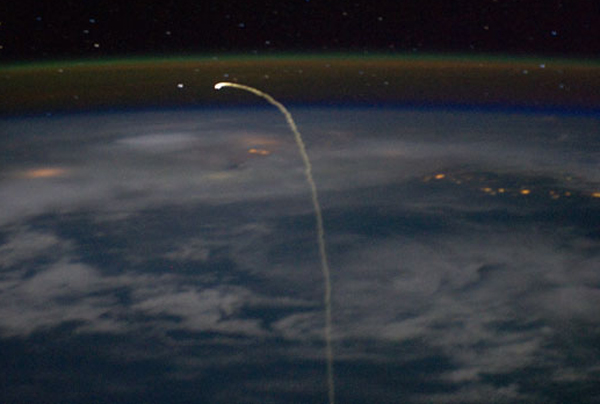 |
| Over the horizon and into history -- astronaut Michael Fossum aboard the International Space Station captured this view of Atlantis' fiery re-entry from his perch in the lab's multi-window cupola. (Credit: NASA) |
"Hey thanks, Butch, great words, great words," Ferguson said. "You know, the space shuttle has changed the way we view the world and it's changed the way we view our universe. There are a lot of emotions today, but one thing is indisputable -- America's not going to stop exploring.
"Thank you Columbia, Challenger, Discovery, Endeavour and our ship, Atlantis," he said. "Thank you for protecting us and bringing this program to such a fitting end. God bless all of you, God bless the United States of America."
Ferguson, Hurley, Sandra Magnus and flight engineer Rex Walheim doffed their 70-pound pressure suits and joined dozens of NASA managers, engineers and contractors, many awaiting layoffs, for a traditional runway inspection, smiling and sharing hugs and handshakes as they celebrated a safe homecoming.
"They have come to be known as the 'final four,' and they did an absolutely incredible job," said NASA Administrator Charles Bolden. "We've been exploring since early in our country's history. What Fergie and his crew did this time was kind of close out this era of our exploration. I want everybody who was involved in this to feel incredibly proud. ... We owe an incredible debt of gratitude to the tens of thousands, if not hundreds of thousands of folk around the country who made all this possible."
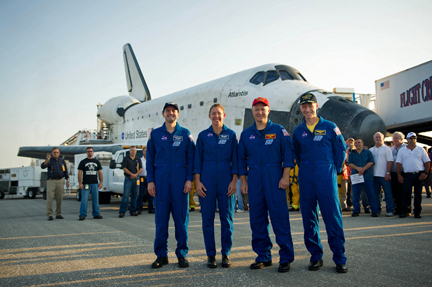 |
| The Atlantis astronauts pose with their space shuttle shortly after landing. Left to right: Rex Walheim, Sandra Magnus, Douglas Hurley and commander Christopher Ferguson. (Credit: NASA) |
"Although we got to take the ride, we sure hope that everybody who's ever worked or touched or looked at or envied or admired a space shuttle was able to take just a little part of the journey with us," he said. "We're going to put Atlantis in a museum now, along with the other orbiters, for generations that will come after us, to admire and appreciate.
"On behalf of the crew, thanks so much for the time and attention," he said. "For the folks at KSC, thank you for this fantastic vehicle. It performed absolutely wonderfully, not a glitch, and it's just as pristine as it was, I hope, on the day that we took it."
Landing closed out a voyage spanning 5.3 million miles and 200 complete orbits since blastoff July 8 from nearby launch pad 39A, a mission duration of 12 days 18 hours 27 minutes and 56 seconds. Over the course of 33 missions, Atlantis logged an estimated 125,935,769 miles, 4,848 orbits and 307 days in space.
Launch Director Mike Leinbach captured the mood of many at the Florida spaceport when he described Atlantis' homecoming as a family affair tinged with sadness and hope for the future.
"I heard nothing but pride out on the runway today," he said. "When I talked to people between the hugs and the pats on the back, the pride that they have of having been part of this amazing program, this amazing bit of history. No one can ever take that away from us."
During a virtually trouble-free mission, Ferguson and his crewmates delivered five-and-a-half tons of supplies and equipment to the International Space Station and helped with a spacewalk to retrieve a failed coolant pump.
The supplies are critical to the space station program. Two companies, Space Exploration Technologies -- SpaceX -- and Orbital Sciences, are building unmanned cargo ships to take over from the shuttle after the fleet is retired with initial test flights expected later this year or early next.
Atlantis' mission was added to the shuttle manifest to deliver enough supplies to keep the station provisioned through 2012 as a hedge against development problems that might delay the commercial cargo ships.
Now, with Atlantis and its crew safely home, the emotional process of remembrance and celebration finally began in earnest as engineers and technicians marveled anew at the technological grandeur of the winged spaceplane and struggled to cope with the reality that it will never fly again.
"Out on the runway, I found myself, as I did with Discovery and Endeavour, taking in the beauty of the vehicle, standing back and taking pictures, taking pictures of the workers, them asking for a picture with me, it was just a family event out there today," Leinbach said. "Hard to describe the emotions. There were good emotions that we brought the crew home safely, and the mission's complete, certainly sadness that it's over and people will be moving on.
"Hate to see them leave," he said, "but that's a reality. I saw grown men and grown women crying today. Tears of joy, to be sure, just human emotions came out on the runway today. You couldn't suppress them."
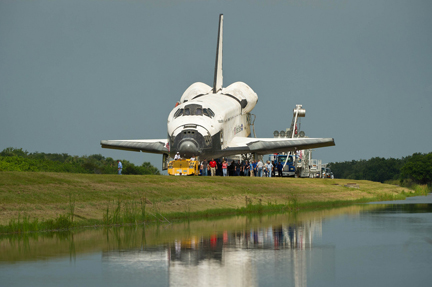 |
| Atlantis is towed from the Shuttle Landing Facility back to its hangar at the Kennedy Space Center. (Credit: NASA) |
"After the wheels have stopped and the displays go blank and the orbiter is unpowered for the final time ... there will be a rush of emotion when we all finally realize that's it, that it's all over, the crowning jewel of our space program, the way we got back and forth from low-Earth orbit for 30 years ... we'll realize that's all over," Ferguson said before launch. "That's going to take a little while to deal with."
The landing also brought into sharp focus the post-Columbia decision by the Bush administration to complete the space station and retire the shuttle to make way for new rockets and the establishment of moon bases by the early 2020s, a program deemed unaffordable by the Obama administration.
Instead of returning to the moon, NASA was told to oversee development of new commercial spacecraft to ferry astronauts to and from the space station. The administration believes that will allow NASA to focus on eventual missions to explore deep space targets ranging from the moon to Mars.
In the meantime, until new commercial spacecraft can be tested and certified for flight -- a process expected to take three to five years at best -- NASA astronauts will be forced to hitch rides to and from the International Space Station aboard Russian Soyuz rockets.
That reliance, along with tight budgets, the lack of a firm timetable and targets for deep space missions lead many to question whether the United States can maintain its leadership on the high frontier.
"The challenge of space is not in building the space systems, it is in building the space team," legendary Apollo 11 Flight Director Gene Kranz said in an email before Atlantis' launch. "With the termination of shuttle operations the NASA and contractor work force that took a decade to build and mature is being destroyed.
"Now, with inept national and space leadership, we stand with both feet firmly planted on the ground. Our nation has surrendered the high ground that the NASA space team captured July 20, 1969."
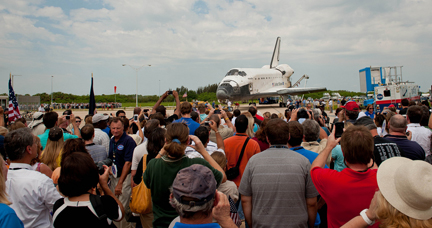 |
| Hundreds of Kennedy Space Center workers celebrated Atlantis' return from space after NASA's final shuttle mission. (Credit: NASA) |
"This final shuttle flight marks the end of an era, but today, we recommit ourselves to continuing human spaceflight and taking the necessary and difficult steps to ensure America's leadership in human spaceflight for years to come," Bolden said in a statement.
"Children who dream of being astronauts today may not fly on the space shuttle but, one day, they may walk on Mars. The future belongs to us. And just like those who came before us, we have an obligation to set an ambitious course and take an inspired nation along for the journey."
Regardless of where one stands on the value of the space shuttle and the wisdom of retiring the fleet before a replacement spacecraft is available, everyone seems to agree on one point: the sheer spectacle of space shuttles taking off and landing will be missed.
"That is the most graceful, beautiful vehicle we've had to fly in space, ever, and it's going to be a long time until you see a vehicle ... as beautiful as that," Walheim said before launch. "How can you beat that? An airplane on the side of a rocket. It's absolutely stunning.
"So I think we lose a little bit of grace, of beauty, and also a little bit of majesty. You can't watch that vehicle roll by without thinking what an amazing achievement America has, that America can build something like that, put people inside and sling them off this Earth into space. It's absolutely amazing."
Over the course of the shuttle program's 30-year space odyssey, Columbia, Challenger, Discovery, Atlantis and Endeavour carried more than 3.5 million pounds of cargo to orbit, brought another 230,000 pounds of equipment back to Earth and deployed 180 satellites and space station components.
It was the only reusable manned spacecraft ever built, the only launch vehicle equipped with an airlock and the first to feature a robot arm, a technological marvel that gave the shuttle its unique ability to precisely position spacewalking astronauts, to deploy and retrieve satellites like the Hubble Space Telescope and to assemble the International Space Station.
Over the past three decades, experiencing virtually no technical problems, the Canadian-built robot arm deployed or retrieved seven satellites, assisted in 115 spacewalks, delivered 30 space station components and grappled 72 payloads. In its final performance, the arm was used Tuesday to carry out a final inspection of Atlantis' heat shield.
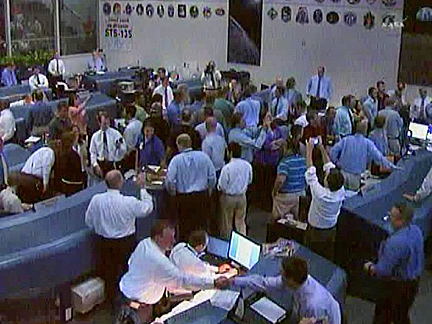 |
| Flight controllers, past and present, gather in the shuttle mission control center in Houston to celebrate and remember the final flight of shuttle Atlantis and the missions that came before. (Credit: NASA TV) |
"There are four phases of change, right? And it doesn't matter what the change is, any major change in one's life you go through these four stages -- it's denial, anger, exploration and acceptance," he said. "We've all been through that now in the shuttle program and we've accepted the fact that it's over. This is the end of the program, and people will move on and do well. ... It's important, but it's not the end of the world. The sun will rise again tomorrow."
Earlier this week, Ferguson told flight controllers finishing their final shifts to pause for a moment before leaving the building, "turn around and make a memory."
He made his own memory Thursday with a textbook descent from orbit and a ghostly, picture-perfect landing.
Flying upside down and backward over the Indian Ocean, Ferguson and Hurley fired the shuttle's twin braking rockets for three minutes and 16 seconds starting at 4:49:04 a.m., slowing the ship by about 225 miles per hour to drop out of orbit.
A half hour later, the shuttle plunged into the discernible atmosphere at an altitude of about 75 miles above the southern Pacific Ocean, enduring the hellish heat of re-entry as it descended along a northeasterly trajectory back toward the Kennedy Space Center.
"Hey Houston, how you doing?" Ferguson called out. "We're doing fantastic. Wish we could share with everybody this really cool glow, it's just amazing outside."
The flight path carried Atlantis high above Central America, across the Gulf of Mexico just west of Cuba and on to Florida, approaching the Kennedy Space Center from the southwest.
Heralded by the shuttle's signature dual sonic booms as Atlantis dropped below the speed of sound, Ferguson took over manual control at an altitude of about 50,000 feet, guiding the shuttle through a sweeping 240-degree left turn to line up on runway 15 for the shuttle program's last landing.
"It's come to a final stop," he called.
And it was so.